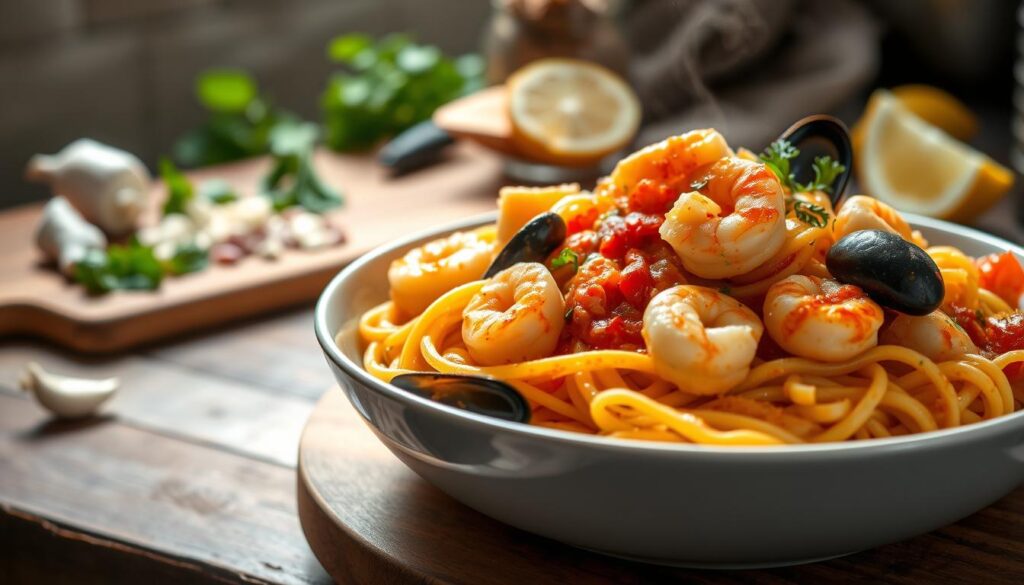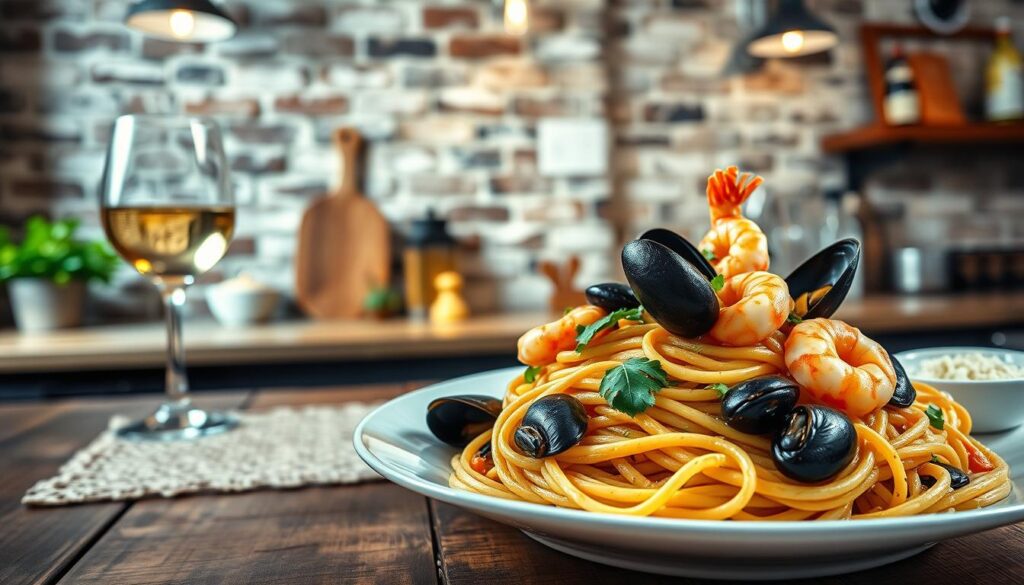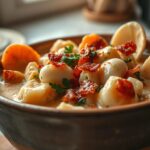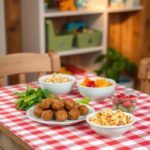Imagine the smell of the ocean in your kitchen. The sizzle of garlic mixes with the scent of fresh seafood. This seafood pasta recipe is not just tasty but also comforting.
It’s perfect for a cozy dinner or a big family event. The best part is, it’s easy to make yet fancy enough for any occasion. With its vibrant flavors and textures, making this dish is an exciting journey.
Let’s explore the world of seafood pasta. We’ll learn how to make your own masterpiece that celebrates the ocean’s bounty.
Key Takeaways
- Cook time for the seafood pasta recipe is approximately 15 minutes.
- Frozen seafood is often used, making it a convenient choice for busy weeknights.
- Incorporating at least one shelled seafood enhances presentation and flair.
- The seafood medley for this recipe requires only 3-4 minutes to cook.
- Pairing pasta with rich tomato sauce complements the flavors of the seafood beautifully.
- With proper storage, leftovers can be enjoyed for up to two days.
- This delightful dish beautifully showcases the culinary magic of seafood.
Introduction to Seafood Pasta
Seafood pasta is a beloved dish in Italian cuisine. It combines pasta with different seafood, creating a dish that tastes great and looks good. This mix of flavors and textures is loved by many, making it perfect for any event.
Deliciousness of Seafood Pasta
Seafood pasta is known for its delicious taste. Imagine creamy sauces or a light garlic and olive oil base, topped with fresh seafood. Shrimp, mussels, and clams add a burst of flavor. Dishes like linguine alle vongole show how simple recipes can be so rich.
Each bite takes you to coastal Italy, where seafood is a big part of life. It’s enjoyed every day and on special occasions too.
Culinary Versatility
Seafood pasta is very versatile. You can change recipes to use what you have and what you like. Adding seasonal seafood, herbs, and spices makes each dish unique.
From quick meals like spaghetti with mussels to more complex dishes like octopus alla Genovese, seafood pasta fits any occasion. Its flexibility makes it a favorite in many kitchens around the world.
Ingredients for Your Seafood Pasta Recipe
Making a tasty seafood pasta dish needs the right mix of flavors and textures. The ingredients are key to the dish’s taste. Choose the best seafood, pasta, and herbs and spices to make your recipe shine.
Essential Seafood Components
A great seafood pasta starts with top-notch seafood. Here are some popular picks:
- 12 small clams, scrubbed
- 12 mussels, scrubbed
- 6 oz. of firm white fish fillets like halibut or swordfish
- 6 oz. of large raw shrimp, peeled and deveined
- 6 oz. of sea scallops
- 1.5 lbs of a seafood mix, typically containing shrimp and calamari
Pasta Selections
The pasta you choose can make a big difference. For seafood pasta, consider these options:
- 12 oz. of spaghetti, or your favorite gluten-free pasta
- Fettuccine or linguine for a broader texture
- Tagliatelle for a more traditional Italian feel
Herbs and Spices
To boost the flavor of your seafood pasta, add fresh herbs and spices. Here are some good choices:
- 2 tablespoons of chopped fresh parsley
- 4 cloves of garlic, sliced or minced
- 1/2 teaspoon of red pepper flakes for a hint of heat
- Salt and black pepper to taste
Best Seafood Pasta Recipe Tips
Making a tasty seafood pasta dish takes careful choices, especially with ingredients. Knowing the difference between fresh and frozen seafood can greatly affect taste and quality. Also, getting the pasta just right is key to a great dish.
Choosing Fresh vs. Frozen Seafood
Deciding between fresh and frozen seafood is a common choice. Fresh seafood usually tastes better and feels nicer in your mouth, perfect for special meals. Frozen seafood is convenient and often just as good, thanks to flash-freezing.
When using frozen, make sure it’s thawed well. Both fresh and frozen can make your dish delicious, depending on what you prefer and what’s available.
Perfect Pasta Texture
The right pasta texture is crucial for a great seafood pasta. Cook your pasta until it’s al dente, usually 8 to 10 minutes. This makes it hold onto the sauce better.
Also, add a bit of salt to the pasta water. About one tablespoon for every five liters helps bring out the flavors.
Finally, toss the pasta with olive oil or butter after draining. This keeps it from sticking and makes it more enjoyable to eat. Following these tips will help you make a seafood pasta dish that’s both tasty and satisfying for everyone.
How to Make Easy Seafood Pasta
Making easy seafood pasta is simple and rewarding. Just a few steps can get you a tasty meal fast. Start by cooking the pasta as the package says. While it cooks, get the sauce ready. This way, you can make a flavorful dish in under 30 minutes.
Simplified Cooking Steps
To make your easy seafood pasta, follow these steps:
- Cook 13 oz. of dry spaghetti in boiling salted water until al dente, which takes 8-10 minutes.
- In a large skillet, melt 3 tablespoons of unsalted butter over medium heat. Sauté 1 medium onion for about 2 minutes until translucent.
- Add 3 cloves of minced garlic and cook for 30 seconds until fragrant.
- Deglaze the pan with ½ cup of dry white wine, scraping up any browned bits from the bottom.
- Incorporate 14 oz. of thawed seafood mix and cook for 1-2 minutes per side until the seafood is opaque.
- Stir in 14.5 oz. of diced tomatoes, ½ cup of heavy cream, and optional 1 tsp of red pepper flakes.
- Simmer for 1-2 minutes before tossing the drained pasta with the seafood sauce.
- Finish the dish with ¼ cup of lemon juice and a garnish of ⅓ bunch of flat-leaf parsley for fresh flavor.
Quick Preparation Techniques
Quick preparation techniques make cooking easier. Chopping ingredients before you start saves time. Frozen seafood is budget-friendly and easy to use, eliminating the need for fresh seafood prep. With just 15 minutes of cooking, you can enjoy a hearty meal without hassle.
| Ingredients | Amount |
|---|---|
| Dry Spaghetti | 13 oz. |
| Seafood Mix | 14 oz. |
| Diced Tomatoes | 14.5 oz. |
| Medium Onion | 1 |
| Butter | 3 tablespoons |
| Heavy Cream | ½ cup |
| Dry White Wine | ½ cup |
| Lemon Juice | ¼ cup |
| Red Pepper Flakes (Optional) | 1 tsp |
By following these steps and techniques, you can make easy seafood pasta quickly and efficiently. It’s perfect for any weeknight meal. Enjoy your delicious creation!
Homemade Seafood Pasta Variations
Exploring homemade seafood pasta reveals a world of flavors. Italy’s regions each have their own cooking styles. This creates a rich mix of flavors for your pasta dishes.
Seafood pasta is versatile. You can add your own twist while keeping it traditional.
Regional Italian Styles
Italy’s south loves tomato-based sauces, adding a fresh taste to seafood. The north, however, goes for creamy sauces. These combine fresh seafood with butter and dairy for a rich feel.
Knowing these styles lets you make your pasta just right. It can match your taste or the event.
Incorporating Different Sauces
Adding various sauces to your seafood pasta brings new flavors. Try marinara for a zesty taste or garlic-and-oil for something lighter. For a richer dish, creamy garlic sauce or herbed butter are great choices.
The secret is to make it your own. Keep it true to Italian traditions while showing off your taste.
| Sauce Type | Flavor Profile | Recommended Ingredients |
|---|---|---|
| Tomato-Based | Fresh and Zesty | Tomatoes, Garlic, Olive Oil, Basil |
| Creamy Garlic | Rich and Decadent | Butter, Cream, Garlic, Parmesan |
| Herbed Butter | Aromatic and Savory | Butter, Fresh Herbs, Lemon Zest |
| Garlic and Oil | Light and Flavorful | Olive Oil, Garlic, Red Pepper Flakes |
Creating a Quick Seafood Pasta Dish
Get ready to wow your guests with a speedy seafood pasta dish. It’s all about quick cooking without losing flavor. By using smart tips, you can whip up a tasty meal in just 30 minutes. Start by prepping your ingredients early and use pre-cooked seafood to make it even quicker.
Time-Saving Tips
- Prep ingredients like garlic, onions, and herbs before starting to cook.
- Use bottled clam juice to add flavor without any extra steps.
- Cook your pasta in the same pot while preparing the seafood to save time.
- Consider using frozen seafood, which can be thawed quickly for convenience.
Pre-cooked Seafood Suggestions
Using pre-cooked seafood can really speed up your quick seafood pasta. Look for pre-cooked shrimp or vacuum-sealed mussels to add to your pan. For instance, you can mix:
- 6 oz. of shrimp (peeled and deveined)
- 12 small clams
- 12 mussels (scrubbed)
- 6 oz. of sea scallops
These seafood choices cook in 4 to 6 minutes. This way, your pasta will be packed with seafood and ready fast.

Healthy Seafood Pasta Recipe Options
A healthy seafood pasta recipe can be both delightful and nourishing. You can elevate your dish with thoughtful substitutions and colorful vegetables. This creates a meal that satisfies your cravings and meets your dietary goals.
Low-Calorie Ingredient Substitutes
Using low-calorie substitutes is key for a lighter seafood pasta dish. Try whole grain or legume-based pasta for more fiber and fewer calories. Swap heavy cream for Greek yogurt for a creamy texture without extra calories.
Adding fresh herbs like parsley or basil adds flavor without adding weight.
Adding Vegetables for Nutrition
Adding vegetables to your healthy seafood pasta boosts nutrition. Zucchini noodles, for example, are gluten-free and increase your veggie intake by about 30%. Cherry tomatoes, spinach, and bell peppers add vitamins and minerals, plus color to your plate.
| Ingredient | Traditional Option | Low-Calorie Substitute |
|---|---|---|
| Pasta | Regular Pasta | Whole Grain or Legume-Based Pasta |
| Cream | Heavy Cream | Greek Yogurt |
| Vegetables | Limited Vegetables | Zucchini Noodles and More Veggies |
By using these low-calorie substitutes and adding vibrant vegetables, you can turn a typical seafood pasta into a healthy meal. Enjoy making a dish that’s as nourishing as it is delicious!
Seafood Linguine Recipe Overview
Making a great seafood linguine dish needs focus and knowing linguine’s special traits. This pasta is flat and thin, perfect for holding sauces. Choose seafood like shrimp, scallops, or mussels to add depth and taste to your dish.
Features of Seafood Linguine
Linguine’s broad surface is key to a good dish. It grabs onto sauces well, making it great for seafood recipes. A classic version combines fresh seafood, garlic, and olive oil for a delicious taste. Adding fresh herbs like basil and oregano can also enhance the flavors.
Cooking Techniques for Linguine
Getting your seafood linguine just right means mastering some cooking skills. First, boil the linguine until it’s al dente, following the package’s guide. Cooking seafood like shrimp or scallops is quick, taking about 4 to 5 minutes. Then, mix the cooked linguine and seafood with a sauce made from garlic, olive oil, white wine, and lemon juice.

Pairing Suggestions for Seafood Pasta
Seafood pasta is more than just a meal; it’s an experience. The right pairings can make it unforgettable. Choose sides and drinks that balance and enhance the flavors of your dish.
Complementary Side Dishes
Seafood pasta is great on its own, but sides make it even better. Here are some ideas:
- Crisp green salad dressed in a light vinaigrette
- Garlic bread for a comforting crunch
- Roasted vegetables that add texture and color
These sides offer a nice contrast to the pasta’s richness. They make every bite a joy.
Best Wines for Seafood Pasta
Choosing the right wine is key to enhancing your seafood pasta. White wines are best for seafood, as they complement without overpowering. Here are some top picks:
- Sauvignon Blanc – refreshing and crisp, pairs well with light seafood dishes
- Chardonnay – great with creamy sauces, excellent for lobster or crab
- Pinot Grigio – versatile; works beautifully with a variety of seafood pasta creations
Whether you’re enjoying shrimp scampi or spicy seafood linguine, the right wine brings out the best flavors. It creates a perfect dining experience.
Storing and Reheating Leftover Seafood Pasta
Leftover seafood pasta can stay delicious if stored and reheated right. Follow these tips to keep your dish tasty and safe.
Refrigeration Guidelines
Store seafood pasta in an airtight container. This keeps it fresh and prevents spoilage. It’s best to eat it within two days for the best taste.
The U.S. Department of Agriculture says leftovers can stay safe at 40°F or below for four days. But for better taste, eat it within two days. If you won’t eat it soon, freezing it for up to six months is an option.
Reheating Tips for Best Flavor
Reheat seafood pasta on low to medium heat. High heat can dry it out. The best way is to use the stovetop, adding a bit of water or broth to keep it moist.
For the oven, heat it to 350°F and cover with foil. This usually takes about 20 minutes. Here are some reheating methods:
- Use a skillet on medium heat.
- In the microwave, stir halfway and add water to keep it moist.
- An air fryer is great for fried seafood.
These tips help keep your seafood pasta flavorful. With the right storage and reheating, leftovers can be just as good as the first time.
Conclusion
In this seafood pasta recipe summary, you’ve seen how versatile and tasty seafood pasta can be. From shrimp scampi to lobster ravioli, there’s something for everyone. Whether it’s a quick dinner or a special occasion, there are endless choices.
Preparing seafood pasta is easy, taking less than 30 minutes. It’s perfect for beginners and experts alike. You can play with herbs, sauces, and seafood to find your favorite flavors. Light sauces and hearty pastas pair well with seafood, enhancing its taste.
Start your cooking adventure with seafood pasta. Mix fresh ingredients like halibut and shrimp with veggies for a healthy meal. Enjoy your dish with a refreshing salad or a glass of wine. Happy cooking!



